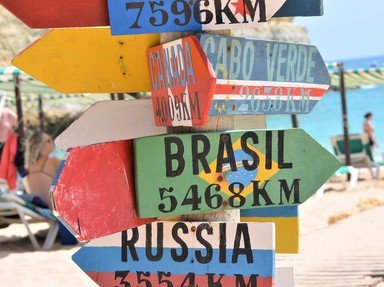Quiz Answer Key and Fun Facts
1. The building in the photo houses a major learning institution in which European capital, whose name means "black pool"?
2. The small but beautiful country of Montenegro ("black mountain"), where the picturesque coastal town of Kotor shown in the photo is located, is part of which major European peninsula?
3. A place that has become famous for all the wrong reasons, the Ukrainian city of Chernobyl is named after which bitter-tasting, flowering plant - whose Slavic name means "black grass"?
4. Nicknamed "The Door to Hell", the Derweze Gas Crater is the best-known feature of the large desert known as Karakum ("black sand"). In which Central Asian country, formerly a part of the Soviet Union, is it found?
5. In ancient Sanskrit texts, the name "Krishnagiri" ("black mountain") was given to the huge mountain range that includes the K2, the world's second-highest peak. To what range - whose current name means "black gravel" - am I referring to?
6. The heart-shaped island of Kuroshima ("black island"), a peaceful tropical paradise famous for cows and sea turtles, is part of which Japanese prefecture - known for its US military bases, and as the birthplace of karate?
7. The black in the name of Melanesia ("black isles") refers to the skin colour of its inhabitants rather than a geographical feature. Which of these Pacific island nations, a former Anglo-French colony with capital Port Vila, is part of Melanesia?
8. The city of Pointe-Noire ("black point") is the Republic of Congo's second-largest city, and its largest port. On which body of water does this city lie?
9. The historic mining town of Ouro Preto in southeastern Brazil has been a UNESCO World Heritage Site since 1980. What does its name mean in Portuguese?
10. Many places in Spanish-speaking countries bear the name of Rio Negro ("black river"). In which South American country, known for its mountains, plains and passionate dances, would you find the province of Rio Negro - whose largest city, Bariloche, is shown in the photo?
Source: Author
LadyNym
This quiz was reviewed by FunTrivia editor
agony before going online.
Any errors found in FunTrivia content are routinely corrected through our feedback system.
